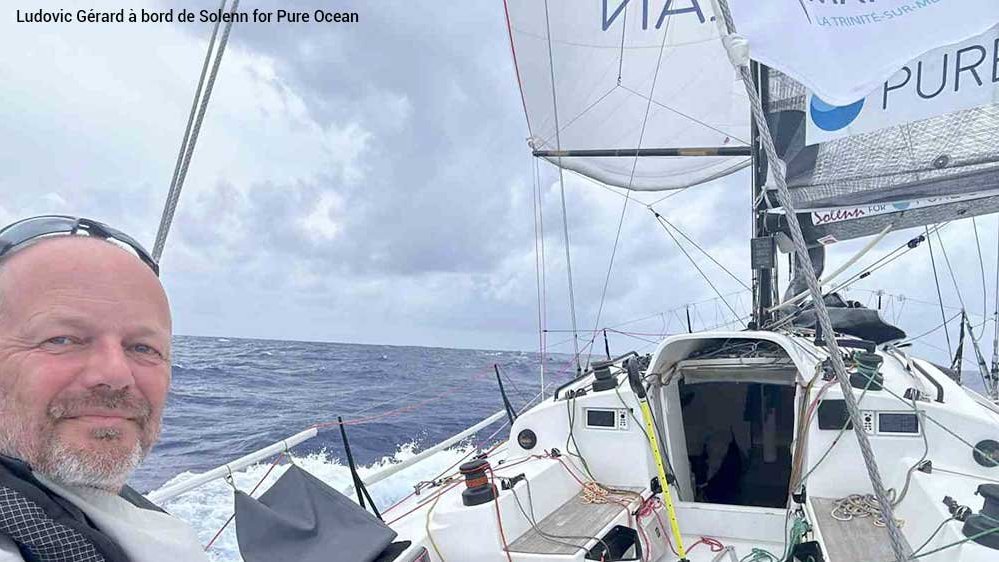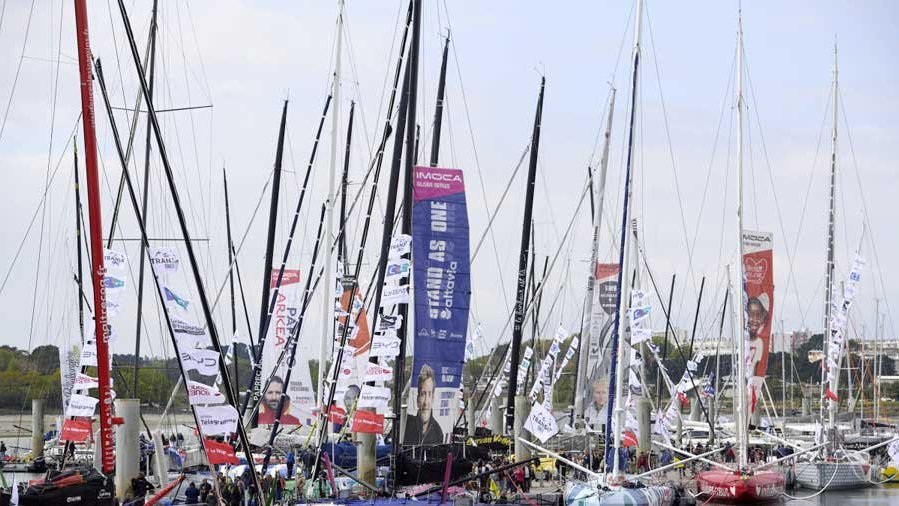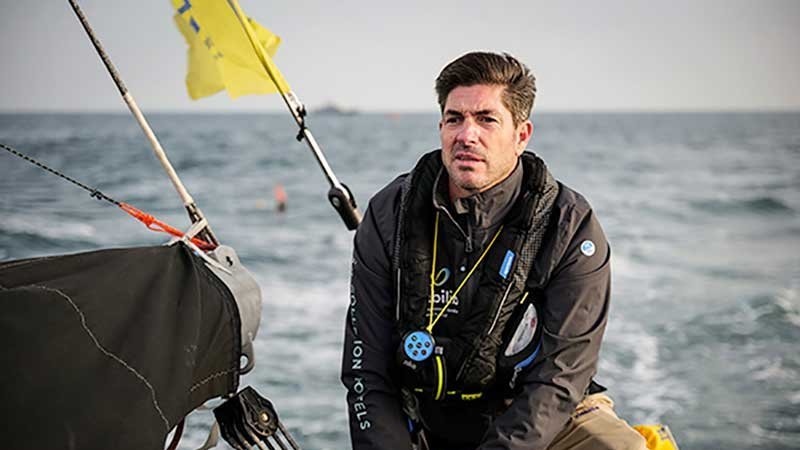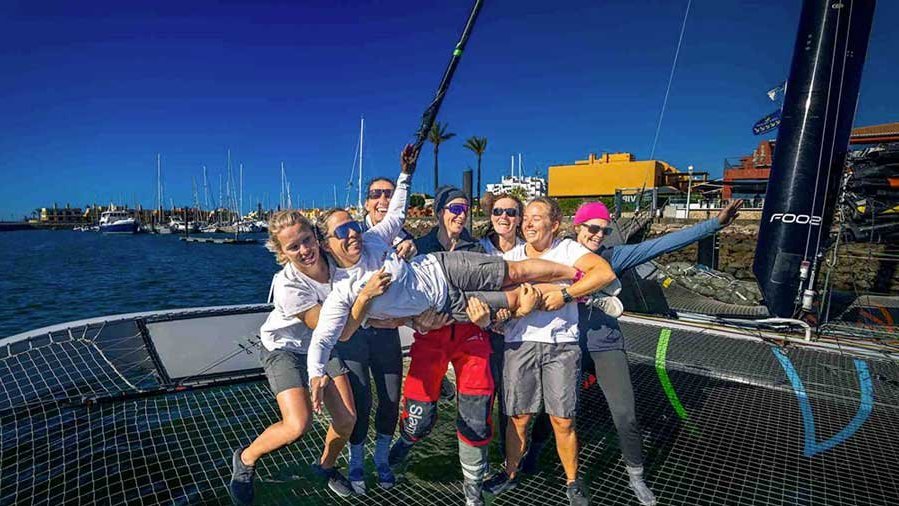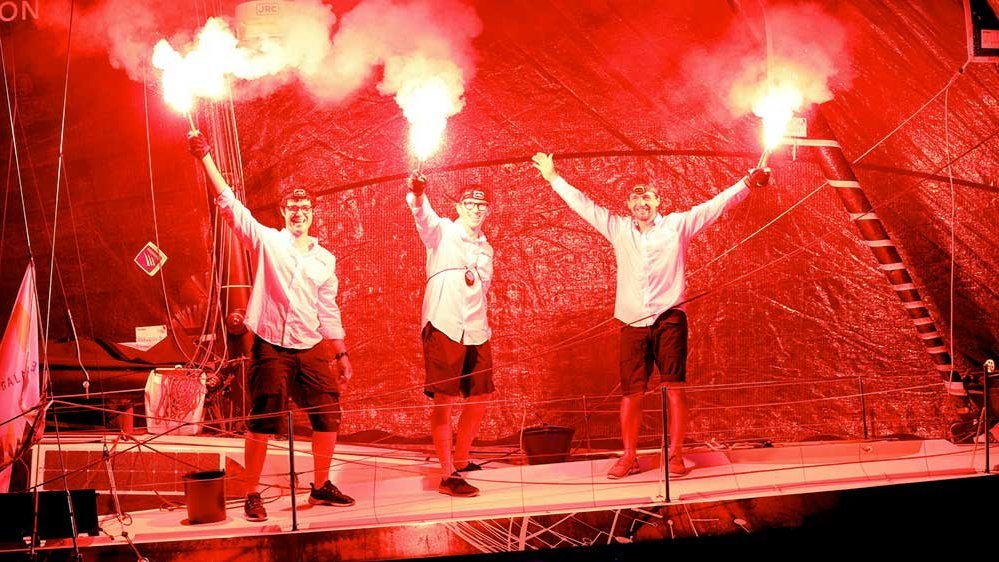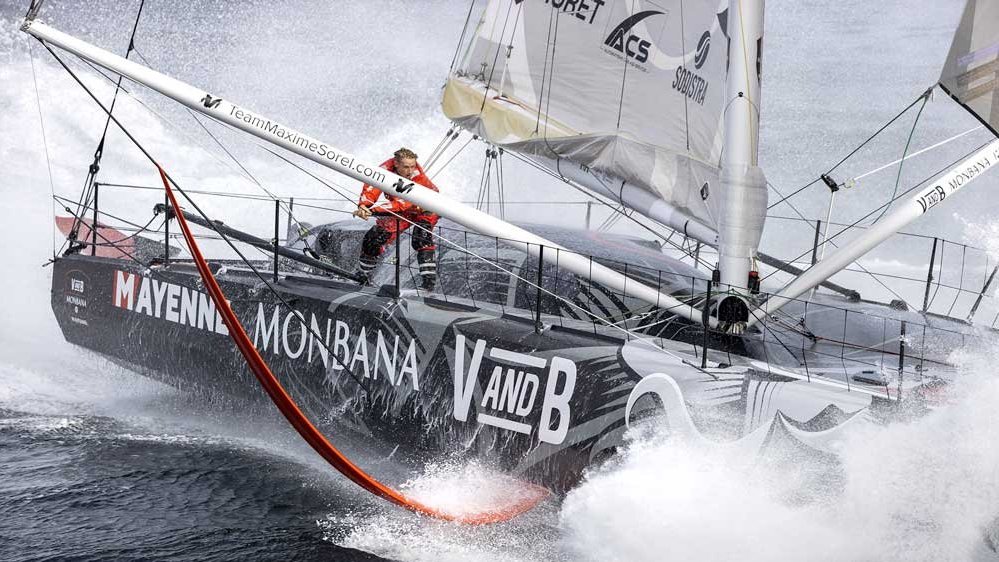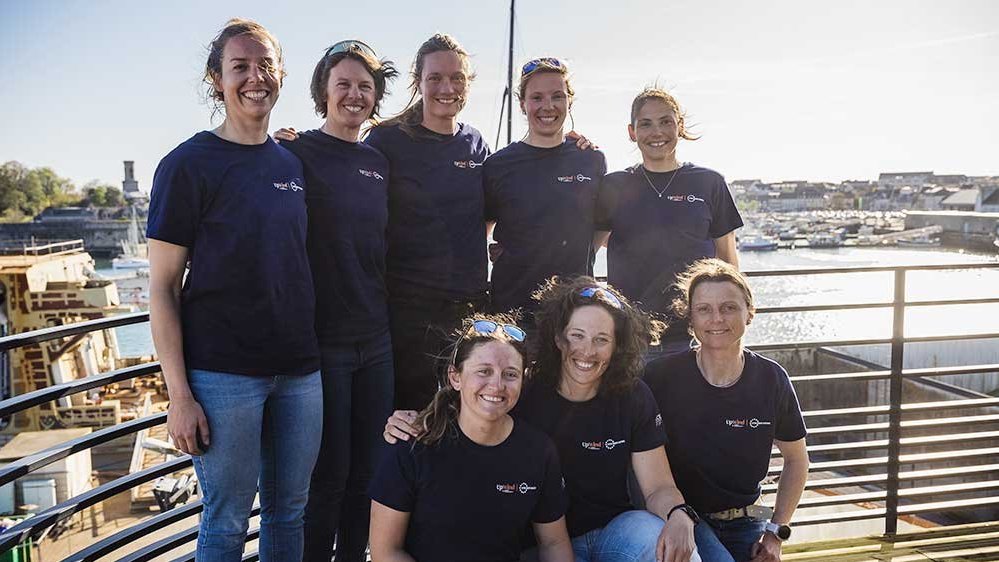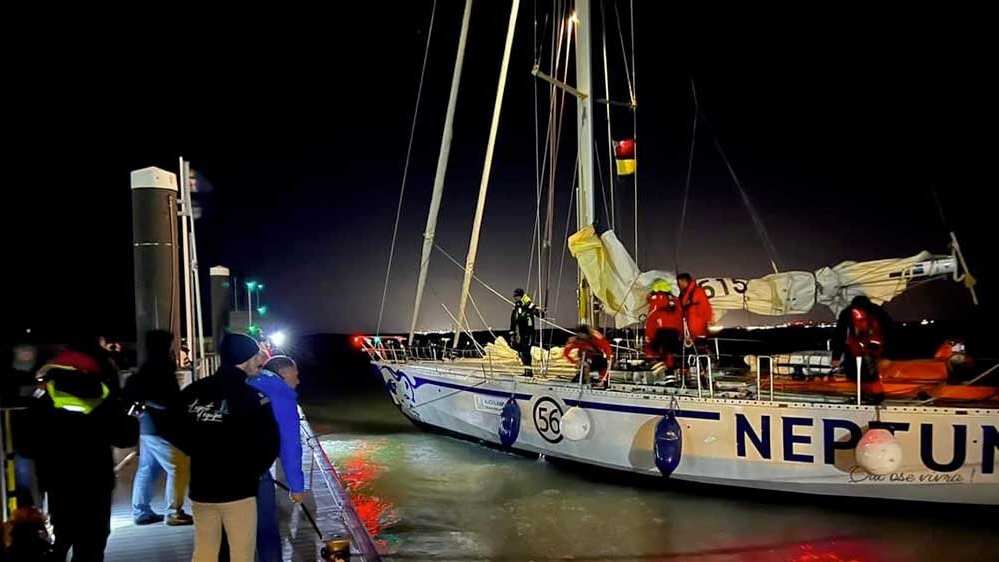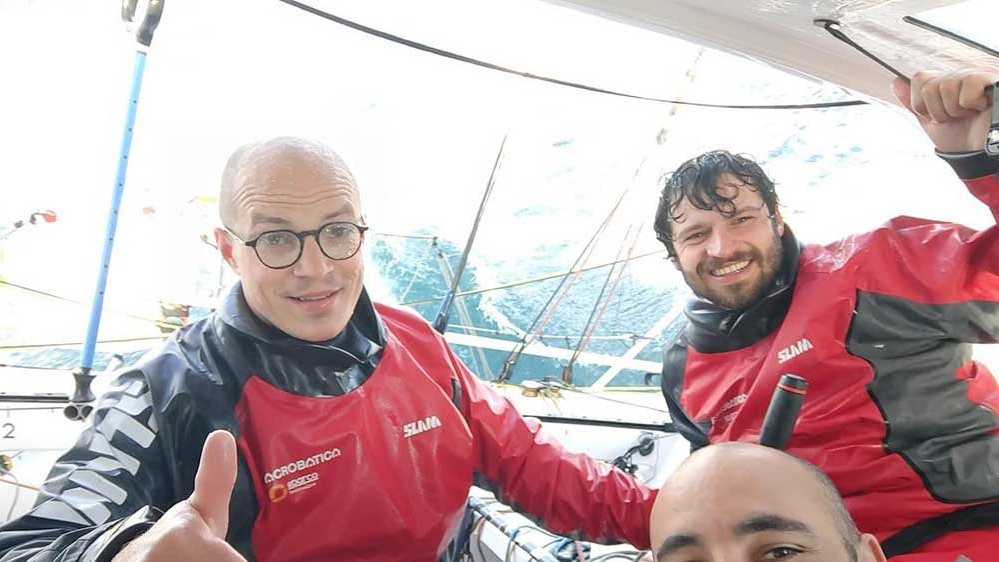
Vendée Globe
Marc Guillemot 4rth but 3rd in Les Sables d’Olonne
"I had doubts until the final tack towards Yeu"
lundi 16 février 2009 –
Toutes les versions de cet article : [English] [français]
To complete his first Vendée Globe the skipper has had to sail for the final 1000 miles, since he was just to the NE of the Azores, with no keel. His keel dropped out of his boat on Monday 9th February and since then the skipper from La Trinité has had to sail prudently but still managed to wrest third from Sam Davies, GBR, (Roxy)by a net 1 hour and 19 minutes and 25 seconds, who finished yesterday. Guillemot received a time compensation of 82 hours for diverting from his course to assist in the evacuation of injured Yann Eliès 800 miles south of Australia in the Southern Ocean.
Accompanied by a fleet of media and spectator boats Guillemot crossed the finish line on a chilly, dark night, ending his epic race having taken a net 95 days 3hours 19 minutes and 36 seconds to complete the course.
With the lightweight VPLP/Verdier design which was tipped by many as potentially one of the quickest new boats in the fleet, it all started well for Guillemot who took the early lead in the Bay of Biscay on the first night of the race making a favourable routing to the south of the pack. While some of the fleet prepared to ride out the storm, Guillemot pushed hard in racing mode and stayed in contention. But on 14th November, having sailed into the lee of the Canaries, Marc found himself stuck in some calms fifty miles to the west of La Palma. Over a frustrating period of 24 hours, he was to give away some 200 miles to the leaders of the fleet. With such high hopes evaporating so early in the race, this was a very difficult stage for Guillemot who took time to get over this, although the skipper of Safran did start a fight back. But this park up really to cost him dearly and he crossed the the Equator on November 22nd in the company of Brian Thompson, Dee Caffari and… Sam Davies.
His race down the South Atlantic showed the shape of things to come, as Safran passed close to Gough Island where Guillemot found himself in conversation with a scientist who was staying on the island. Neither was this his last island encounter. On 11th December, there was the first of a chapter of incidents that transformed his race from out and out competition, battling to win to a great human adventure which mixed ill fortune and fascinating and, at times, deeply stressful experiences. He hit a sea mammal on 11th December and broke his starboard daggerboard. He did not know then that his keel had also been damaged by the impact. Then, on 16th December part of his mainsail track snapped off forcing him to sail with one or two reefs in the mainsail.
On 18th December, Guillemot’s race took a new turn. He was informed by the race directors that Yann Eliès had been injured when his boat was stopped by a big wave and that, with a fractured femur, he was unable to move aboard his Generali. In agreement with the race directors he immediately diverted. Having experienced a similar situation himself twenty years before when he had to wait with a broken pelvis for the rescue team to reach Jet Services IV, after the catamaran capsized ironically he was perhaps the best equipped mentally to know what Yann was going through,. For Marco, there was not the slightest hesitation : he headed straight for Yann and did everything possible until the Australian rescue team took off the injured sailor.
Marc spent hours circling Generali offering words of encouragement on the VHF, trying to throw sedatives and water through the companionway. Eliès desperately needed them but his own supplies were just metres from him and he could not summon the strength to get to them. Guillemot’s psychological support was vital and without any doubt a key element in Yann making a huge effort to finally reach his painkillers, some food and water.
Guillemot had to be dissuaded from jumping from his Open 60 to sail Generali towards help and refused to leave the area until he was sure that the Australian navy had the skipper of Generali safely on board. From there it was not easy to work himself back up into race mode again.
In spite of everything, Guillemot continued to fight back : he made his first pit stop off Auckland Island, a few hundred miles south of New Zealand to attempt to repair his mast, seen by two scientists carrying out research on the island. He would repeat the exercise at Port Stanley in the Falklands watched by many tourists, who were visiting on a cruise of the area. Certainly by the conclusion of his race Marc Guillemot is the sailor, who had encountered the most people during his Vendée Globe.
To cap it all he has fought on from the loss of his keel almost a thousand miles from the finish. The weather conditions were not too unfavourable, as the last spell of heavy weather had passed. His former rival, Roland Jourdain had already shown what was possible by covering 600 miles to the Azores without his keel. He decided to continue, making it clear that he was still in the race and still aiming for a place on the podium, which he achieved tonight. Marc Guillemot (Safran) crossed the Les Sables d’Olonne finish line at 1h21min36sec GMT tonight (Sunday) to clinch a hard won third place in this epic sixth edition of the Vendée Globe solo non stop around the world race.
To complete his first Vendée Globe the skipper has had to sail for the final 1000 miles, since he was just to the NE of the Azores, with no keel. His keel dropped out of his boat on Monday 9th February and since then the skipper from La Trinité has had to sail prudently but still managed to wrest third from Sam Davies, GBR, (Roxy) who finished yesterday. Guillemot received a time compensation of 82 hours for diverting from his course to assist in the evacuation of injured Yann Eliès 800 miles south of Australia in the Southern Ocean.
Marc Guillemot after his arriving…
“The last week was very stressful and crossing the line was a great relief and the stress of the race all came out at that point. There was the sporting element which interested me. The adventure wasn’t really my thing. A lot happened. Firstly a tactical mistake in the Canaries after a good start in the Bay of Biscay. I had problems with my pilots.”
“Off the Kerguelens I hit a sea mammal and went from 20 knots to zero and it took me a while to get over that. I had never been so scared on a boat.”
“Then the race was on again with Vincent and Armel at the West Australia Gate.
Denis Horeau called me to inform me about Yann Eliès. That was a very emotional moment as I knew he was injured but couldn’t do anything. I felt powerless to do anything. I’d been through a similar experience and imagine the pain he was facing.”
“I filmed and talked to Yann and the rescue team. The rescue was going so well and I felt strange filming it and just started to laugh. Even though I didn’t have any physical contact, this will remain a memory of the race. Yann left and I chatted to the Australians, who threw me a packet. I didn’t touch the red wine –you can check ! In any case I’ll be sharing it with Yann. They thought I was crazy and took a photo of me. As I hoisted the gennaker I saw the Australian boat 10 metres away taking pictures and I couldn’t bear away. Another weird moment !”
“ Then there were the islands. The Canaries where I was stuck, then Gough Island where I saw an explorer and we chatted in English on the VHF.”
“I decided to stop at Auckland Island for a pit stop. I had prepared it and it was a great place, although not very warm. I was in a sheltered bay and there were things moving on the beach- 3 explorers and 150 sea elephants. A funny encounter, even if climbing the mast wasn’t so much fun. They couldn’t make out what was going on. I didn’t manage to do what I wanted. I thought I’d have a quiet night, but the sea elephants were very noisy.”
" In the Pacific I was racing with Sam and the leaders, Jean Pierre, Mich, Bilou… I passed the Horn but didn’t manage to see it. The mast track came off again in the Pacific ina different place so I put in to the Falklands. There were the famous cruise boats that Bilou saw. They put in to the Falklands for supplies. Sailing up the coast of Brazil I came across the fishermen with their long lines, which stretched out for a couple of miles. Suddenly I saw them screaming at me. Fortunately they were limited to 5 or 6 knots. I suddenly realised that I was towing the markers, but fortunately they broke free at that point so they stopped chasing me."
"Close to the coast, there was a lot of stress with the oil rigs."
" The Equator and Doldrums were more or less in same place. Then there was the upwind sailing in the trade winds, which is the worst part in terms of comfort and fun. "
"After the collision (with the sea mammal) I contacted Guillaume Verdier about the keel shuddering but was reassured. Then by the North Atlantic it had got much worse. The seas were heavy after the storm passed through. They advised me about how to lash the keel in place. I thought I’d succeeded, but at that moment the keel head slid down. In a way it was something I hoped would happen, because a keel swinging around is a source of stress. So losing the keel was a great relief."
"Samantha was just ahead and I played around with the ballast and sails trying to find the way to sail safely. I think I was close to the edge several times. I slept with the sheet in my hand paying attention to the heel of the boat. The problem is you don’t get much sleep like that. I wouldn’t like to go through that again."
" I had the right quantity of food with me, as I only started on the freeze dried food yesterday. Christine sorted things out for me like creams for my hands."
"Everyday I sent my route in to designers and my team based around a certain percentage of the boat’s polars. Sailing upwind I had no idea. In the end sometimes I was above and sometimes below my estimates. When I saw head winds I was afraid it would be very difficult. This morning the routing said I would arrive at 3 so there was a lot of uncertainty, but hoping it was possible. The glimmer of hope was what kept me going. Yann told me to play it like a Figaro leg. He was right, but I’m exhausted. It was very close. Late this afternoon I had doubts until the final tack towards Yeu."
" I was wondering whether Pindar had lost her keel as she was only doing the same speed as me. It was a challenge fighting it out with Brian. "
"It was very strange seeing the motorboats surround me and I couldn’t see the line very easily. You go from a quiet world of being alone to noise and people, although I like seeing my friends. I’m happier with the design choices at the finish than at the start ! There were a lot of complementary ideas that came together and this evening finishing I really enjoyed sailing her. She’s a great boat !"
" The UFO detector was on in most of the south. I didn’t detect any growlers, perhaps because I avoided places where growlers could be found. The scientists would have liked to see it tested where you find growlers. More seriously, I think it’s an interesting device."
Voir en ligne : Photo ThMartinez/Sea&Co / www.thmartinez.com
Les temps de Marc Guillemot
![]() Passage à l’équateur : 13j 03h 59’
Passage à l’équateur : 13j 03h 59’
![]() Passage à Bonne Espérance : 27j 06h 08’
Passage à Bonne Espérance : 27j 06h 08’
![]() Passage au cap Leeuwin : 38j 11h 28’
Passage au cap Leeuwin : 38j 11h 28’
![]() Passage de l’antiméridien : 49j 22h 13’
Passage de l’antiméridien : 49j 22h 13’
![]() Passage du cap Horn : 63j 19h 28’
Passage du cap Horn : 63j 19h 28’
![]() Passage à l’équateur : 81j 12h 13’
Passage à l’équateur : 81j 12h 13’
![]() Arrivée aux Sables d’Olonne : 95j 03h 19’ 36’’
Arrivée aux Sables d’Olonne : 95j 03h 19’ 36’’
Arrivées du Vendée Globe
![]() 1-Michel Desjoyeaux (Foncia) 84j 03h 09’ 08’’
1-Michel Desjoyeaux (Foncia) 84j 03h 09’ 08’’
![]() 2-Armel Le Cléac’h (Brit Air) 89j 09h 39’ 35’’ (bonification de 11h incluse)
2-Armel Le Cléac’h (Brit Air) 89j 09h 39’ 35’’ (bonification de 11h incluse)
![]() 3-Marc Guillemot (Safran) 95j 03h 19’ 36’’ (bonification de 82h incluse)
3-Marc Guillemot (Safran) 95j 03h 19’ 36’’ (bonification de 82h incluse)
![]() 4-Samantha Davies (Roxy) 95j 04h 39’ 01’’ (bonification de 32h incluse)
4-Samantha Davies (Roxy) 95j 04h 39’ 01’’ (bonification de 32h incluse)
Dans la même rubrique
Vendée Globe : Sam Davies finishes third in the Sables d’Olonne
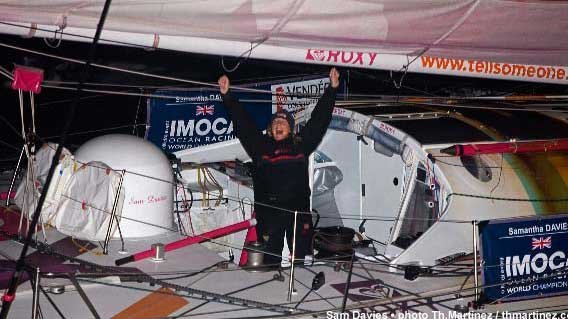
Vendée Globe • D 92 : Marc Guillemot : "I really want to finish"
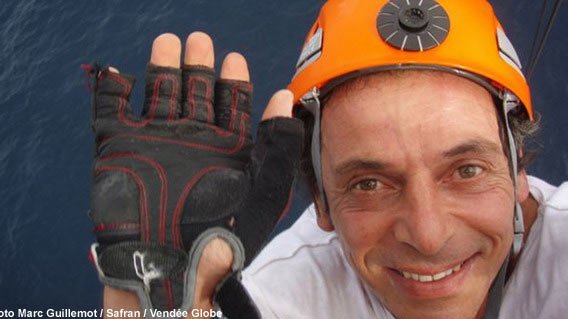
Vendée Globe : Armel Le Cléac’h 2nd to Les Sables d’Olonne

Vendée Globe : Desjoyeaux’s day in Les Sables

 Sea, Sail & Surf news
Sea, Sail & Surf news